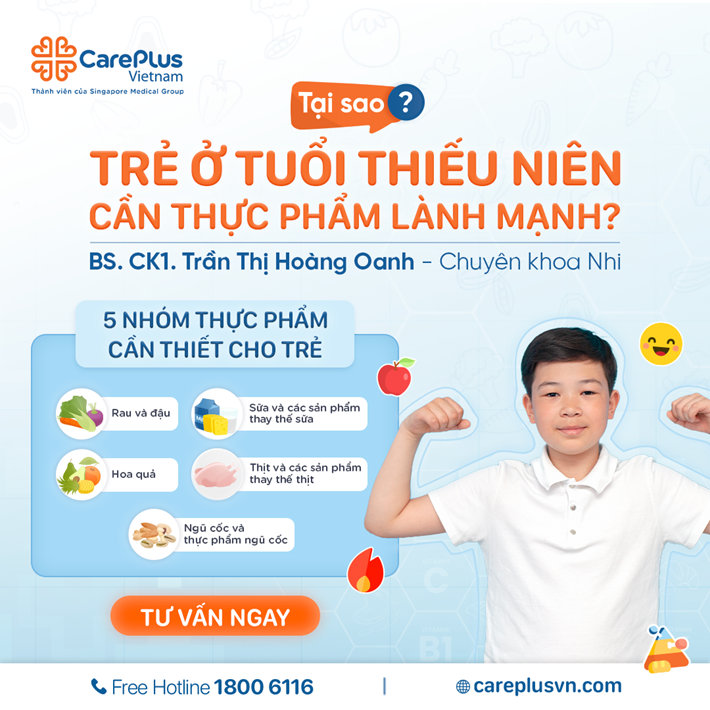Healthy Foods for Teens and Adolescents
Trẻ thiếu niên trải qua những thay đổi lớn về thể chất ở tuổi dậy thì. Trẻ cần thêm dinh dưỡng để thúc đẩy những thay đổi về thể chất này, điều đó có nghĩa là trẻ cần ăn thực phẩm lành mạnh. Mức độ hoạt động thể chất và giai đoạn phát triển của con bạn quyết định lượng thực phẩm lành mạnh mà trẻ cần nhưng bạn sẽ nhận thấy rằng con thèm ăn hơn ở tuổi dậy thì.

12/31/2024 10:20:39 AM
Healthy foods for young people include a variety of fresh options from the five food groups:
- Vegetables and legumes
- Fruits
- Grains and cereals
- Dairy and alternatives
- Meat and meat substitutes
Each food group provides essential nutrients that your child's body needs to grow and function. A diverse diet that includes all five groups is vital for balanced nutrition.
1) Fruits, Vegetables, and Legumes
These foods offer energy, vitamins, antioxidants, fiber, and hydration. They help protect your child against illnesses like heart disease, stroke, and certain cancers.
- Encourage colorful fruits, vegetables, or legumes in every meal and snack.
- Wash them thoroughly with saltwater or diluted vinegar and keep the edible peel to retain nutrients.
- Set a good example by enjoying fruits and veggies yourself. Your child is more likely to follow suit if they see you doing so.
2) Grains and Cereal Products
This group includes rice, bread, corn, potatoes, sweet potatoes, noodles, oats, and barley. They provide energy for growth, development, and learning.
- Opt for whole grains or low-GI (glycemic index) foods like whole-wheat bread, pasta, and sweet potatoes for sustained energy and satiety.
3) Dairy and Dairy Alternatives
Dairy products such as milk, cheese, and yogurt are excellent sources of calcium and protein. During puberty, these nutrients help achieve peak bone mass and build lifelong bone strength.
- Offer a variety of dairy products daily.
- If your child cannot consume dairy, choose alternatives high in calcium like soy milk, fortified cereals, tofu, kale, bok choy, nuts, and canned fish with bones.
4) Meat and Meat Substitutes
This includes beef, lamb, pork, chicken, and fish. Alternatives include eggs, beans, lentils, tofu, and nuts. These foods provide protein vital for muscle development, especially during puberty.
- Omega-3 fatty acids from fish oils aid brain development and learning.
- Iron promotes muscle growth and increases blood volume, crucial for girls starting menstruation.
- Protein-rich animal foods also supply zinc and vitamin B12.
Healthy Drinks for Teenagers
- Water is the healthiest and most affordable drink, and fluoridated tap water supports strong teeth.
- Low-fat milk is another excellent choice, rich in calcium for growing bones.
Foods and Drinks to Limit
Encourage occasional consumption of “discretionary foods,” making room for healthier daily options.
- Avoid or limit highly processed snacks like instant noodles, sausages, chips, pies, and pastries. These are high in salt, saturated fats, and sugar but low in fiber, increasing the risk of obesity and type 2 diabetes.
- Reduce sugary drinks like sodas, flavored water, sports drinks, and sugary milk. These contribute to weight gain, poor nutrition, and tooth decay while reducing appetite for healthy meals.
- Avoid caffeinated drinks such as coffee, tea, energy drinks, and certain sodas. Caffeine can hinder calcium absorption and disrupt sleep and focus at school.
Healthy Snack and Dessert Alternatives
Hungry teens often seek snacks. Encourage them to choose from healthy options like nuts, low-fat cheese, yogurt, fresh fruits, or vegetables.
For dessert, sliced fruit or yogurt is a great choice, saving sugary treats like chocolate or cakes for special occasions.
Key Takeaways
- Pre-teens and teenagers need a varied diet from all five food groups.
- Healthy foods are rich in essential nutrients for puberty and growth.
- Minimize foods high in salt, fats, sugars, or caffeine. Choose water and natural foods for snacks and desserts to keep your child healthy and energized.